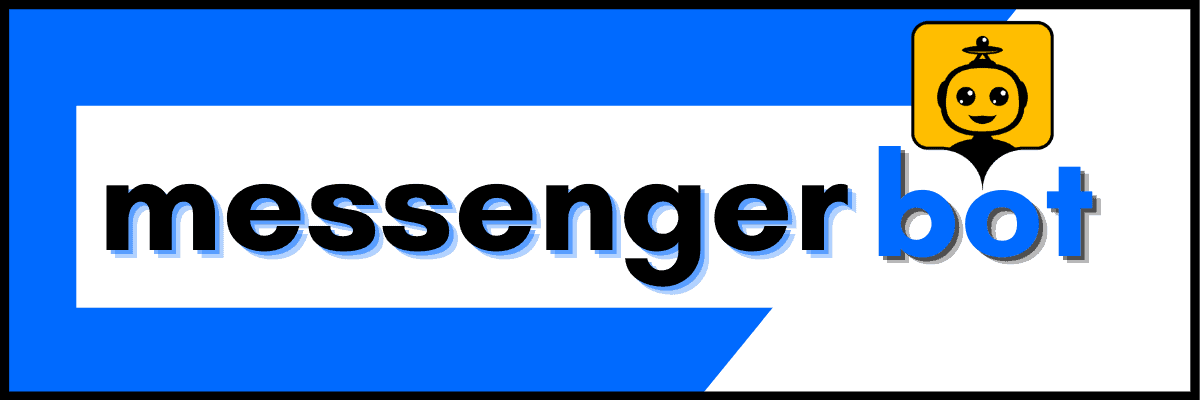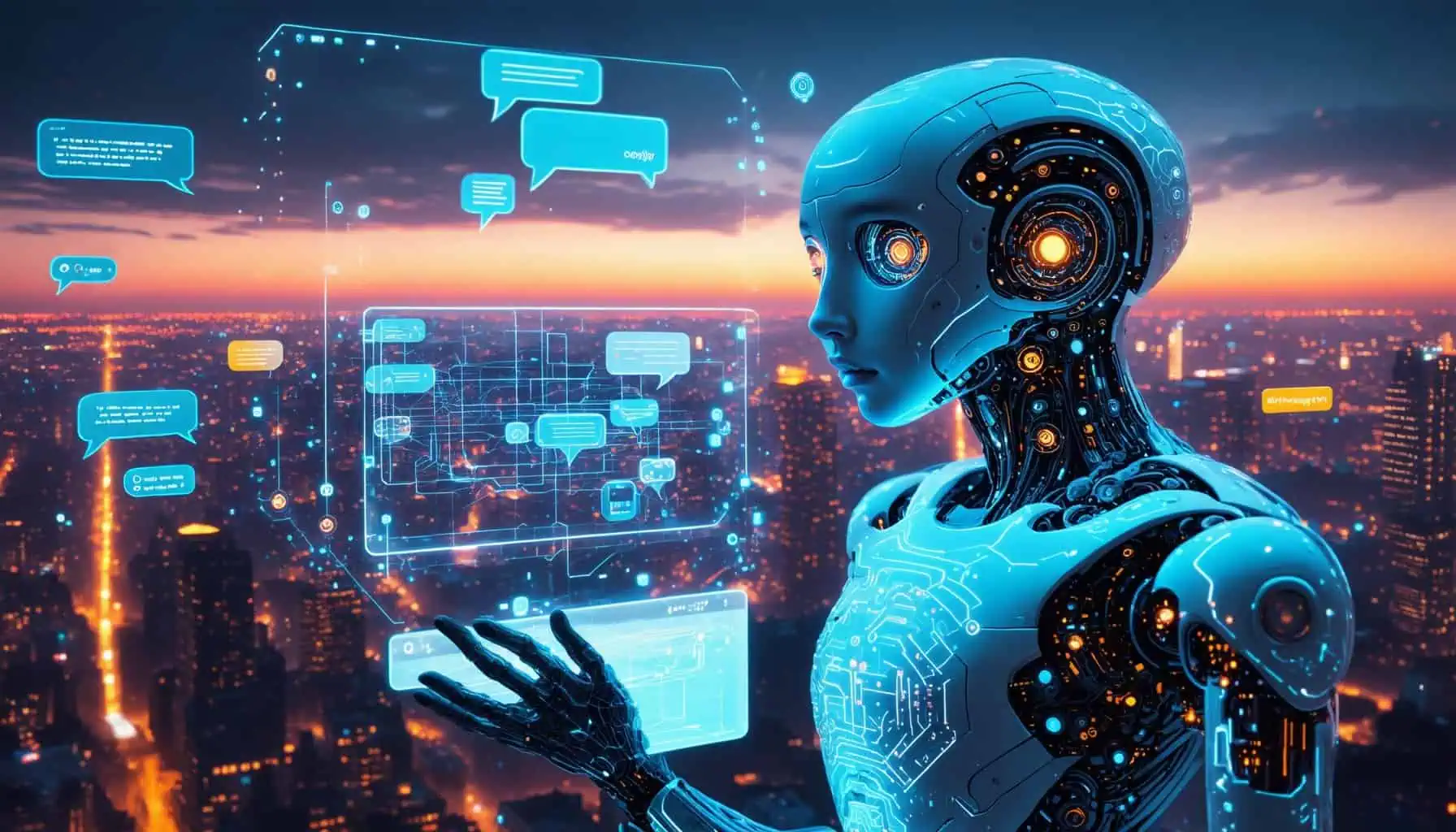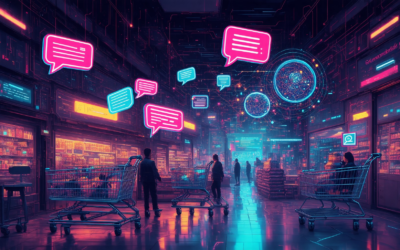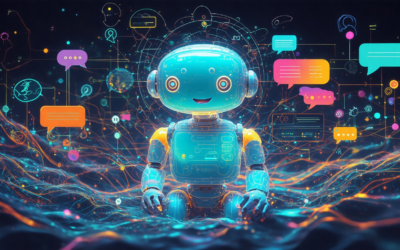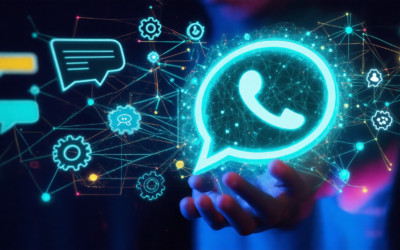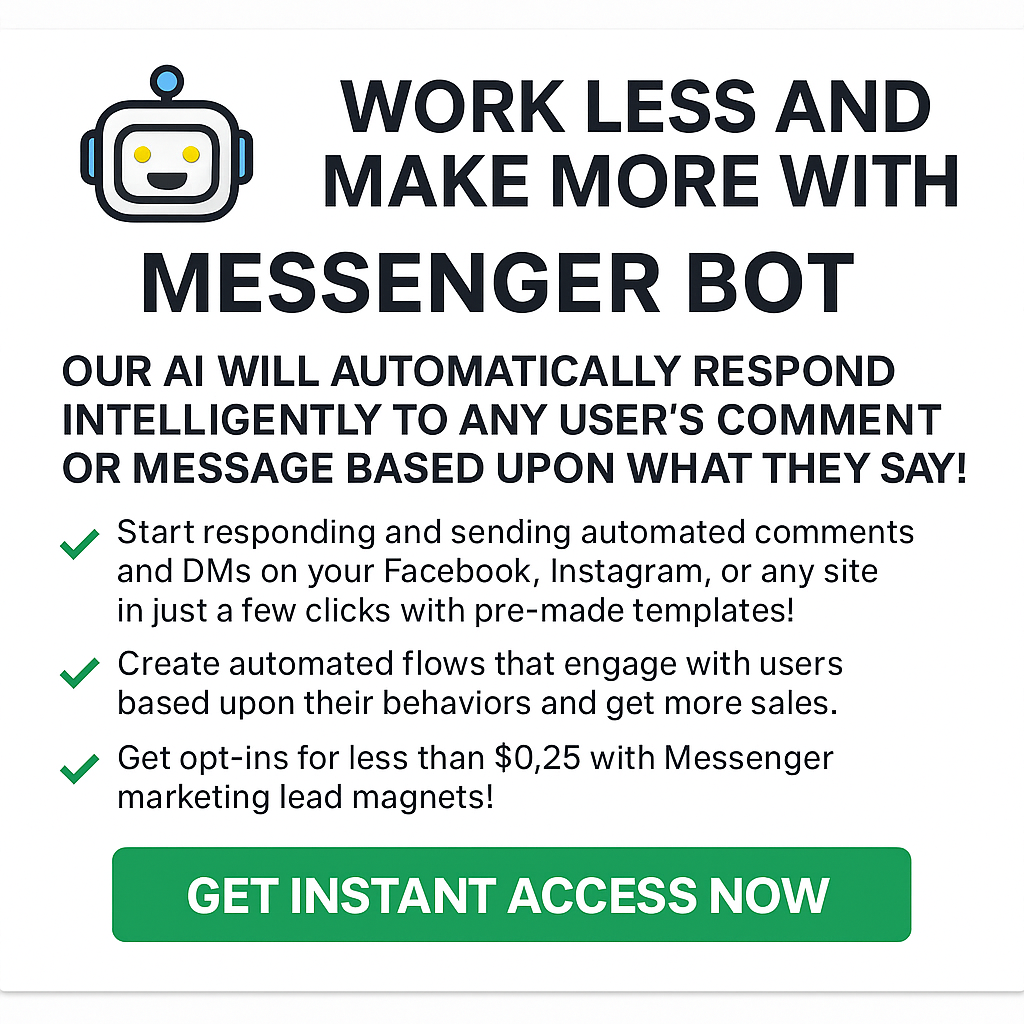Key Takeaways
- Chatbots, such as ChatGPT, Siri, and Alexa, are transforming user interactions by leveraging advanced AI and natural language processing (NLP).
- Four primary types of chatbots—menu-based, rule-based, AI-powered, and voice chatbots—serve distinct functions, enhancing customer engagement and support.
- Real-world applications of chatbots span various industries, including healthcare, e-commerce, and education, demonstrating their versatility and effectiveness.
- Personalization, 24/7 availability, and quick response times are essential features that contribute to successful chatbot experiences, fostering user satisfaction.
- As technology evolves, the smartest AI chatbots, including Google Bard and Microsoft Copilot, are setting new benchmarks for conversational capabilities and user engagement.
In the rapidly evolving landscape of artificial intelligence, chatbots have emerged as pivotal tools for enhancing user interaction and streamlining communication. This article, titled Discovering the Best Chatbot Examples: From Famous AI Interactions to the Smartest Chatbots in 2025, delves into the best chatbot examples that have not only captured public attention but also set benchmarks in the industry. We will explore the most famous examples of chatbots, dissect the four primary types of chatbots, and highlight real-world applications that showcase their effectiveness. Additionally, we will compare leading technologies to identify the smartest AI chatbots and analyze the capabilities of popular voice assistants like Alexa and Siri. By the end of this article, you will gain valuable insights into what makes a chatbot successful and discover the best AI chat apps available today, paving the way for a deeper understanding of the future of chatbots and their impact on user experience.
What is the most famous example of a chatbot?
The most famous example of a chatbot is undoubtedly ChatGPT, developed by OpenAI. This advanced AI language model has gained significant recognition for its ability to engage in human-like conversations, answer questions, and assist users across various domains.
AI Chatbot Examples: A Look at the Most Recognized
Here are some notable chatbot examples that showcase the versatility and application of AI in real-world scenarios:
- ChatGPT by OpenAI: Renowned for its conversational abilities, ChatGPT can generate coherent and contextually relevant responses, making it a popular choice for customer support, content creation, and educational purposes.
- Siri by Apple: As one of the first virtual assistants, Siri uses natural language processing to perform tasks and answer queries, integrating seamlessly with Apple devices.
- Alexa by Amazon: This voice-activated assistant not only plays music and controls smart home devices but also provides information and engages users in conversation.
- Cleverbot: An early example of a chatbot that learns from interactions, Cleverbot has been entertaining users with its witty responses since 1997.
- Mitsuku (Kuki): This award-winning chatbot has won the Loebner Prize multiple times for its ability to simulate human conversation, showcasing the potential of AI in social interaction.
- Replika: Designed as a personal AI companion, Replika learns from user interactions to provide emotional support and companionship, highlighting the therapeutic applications of chatbots.
- Landbot: A no-code chatbot builder that allows businesses to create conversational experiences for customer engagement, showcasing the growing trend of chatbots in marketing.
These examples illustrate the diverse applications of chatbots in enhancing user experience, providing customer service, and facilitating communication. As AI technology continues to evolve, the capabilities of chatbots are expected to expand, making them an integral part of digital interaction.
Chatbot Artificial Intelligence Examples in Popular Culture
Chatbots have also made their mark in popular culture, influencing how we perceive artificial intelligence and its capabilities. Here are some notable instances:
- HAL 9000 from 2001: A Space Odyssey: This fictional AI character is known for its conversational abilities and complex interactions with humans, raising questions about trust and technology.
- Data from Star Trek: The Next Generation: An android with advanced AI, Data showcases the potential for emotional intelligence and human-like interactions, blurring the lines between human and machine.
- Her: This film features an AI operating system that develops a romantic relationship with its user, exploring themes of love and companionship in the digital age.
- Westworld: The series presents AI hosts that exhibit human-like consciousness and emotions, prompting discussions about morality and the future of AI.
These cultural representations highlight the growing fascination with chatbots and AI, reflecting both their potential and the ethical considerations they bring to our society.
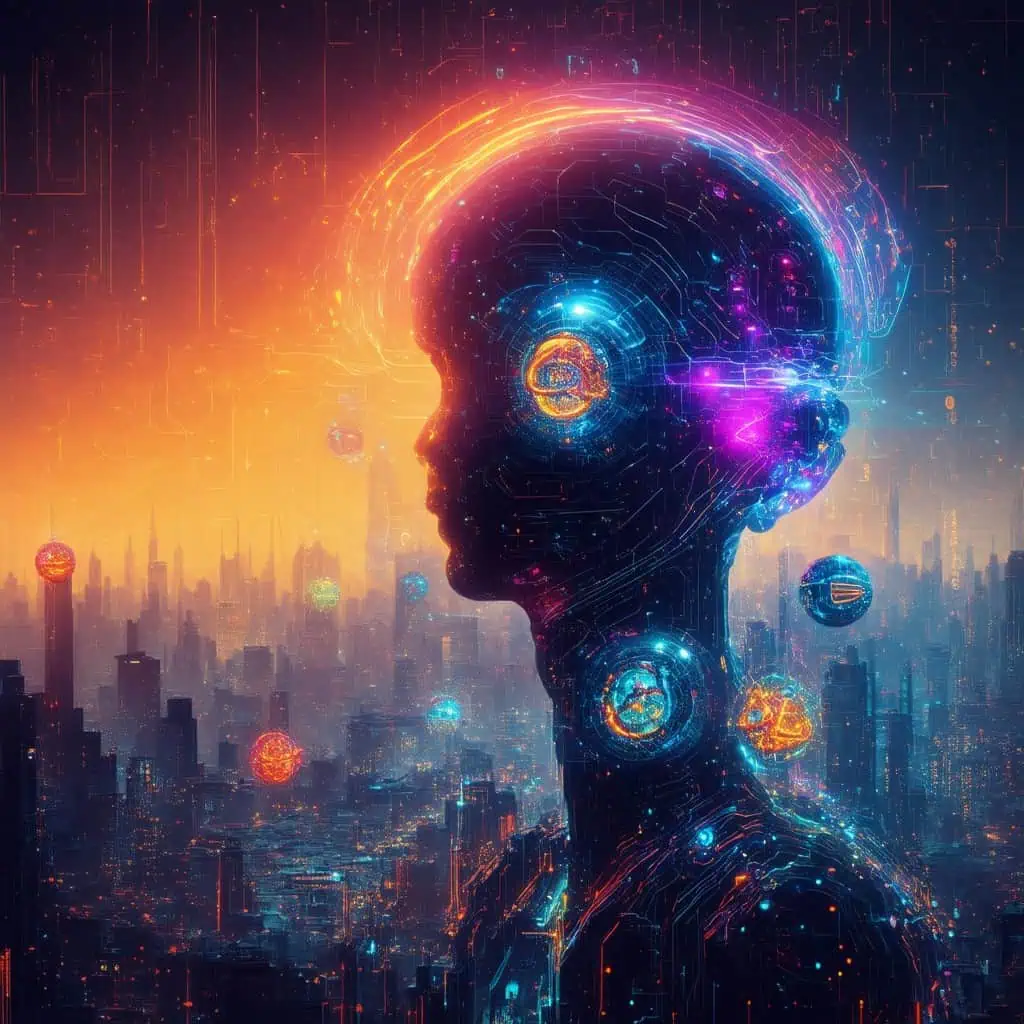
What are the 4 types of chatbots?
There are four primary types of chatbots, each serving distinct purposes and functionalities:
- Menu or Button-Based Chatbots: These are the simplest form of chatbots, providing users with predefined options to choose from. Users interact by clicking buttons or selecting menu items, making it easy for businesses to guide conversations without complex programming. They are commonly used for FAQs and basic customer service inquiries.
- Rule-Based Chatbots: Also known as decision-tree chatbots, these operate based on a set of predefined rules and scripts. They can handle more complex queries than menu-based bots by following a logical flow, but they are limited to the scenarios programmed into them. Rule-based chatbots are effective for structured interactions, such as booking appointments or processing orders.
- AI-Powered Chatbots: These chatbots utilize natural language processing (NLP) and machine learning to understand and respond to user queries more intelligently. They can learn from interactions and improve over time, making them suitable for more dynamic conversations. AI-powered chatbots can handle a wide range of topics and provide personalized responses, enhancing user experience significantly.
- Voice Chatbots: Designed for voice interaction, these chatbots use speech recognition technology to understand spoken commands. They are increasingly popular with the rise of smart speakers and voice assistants. Voice chatbots can perform tasks such as setting reminders, providing information, or controlling smart home devices, making them versatile tools for hands-free interaction.
Understanding the Best AI Chatbots: Types and Functions
Understanding the different types of chatbots is crucial for businesses looking to implement effective communication strategies. Each type serves unique functions that cater to various user needs. For instance, AI chatbot uses and applications highlight how AI-powered chatbots can enhance user engagement through personalized interactions. Moreover, businesses can leverage customer service chatbot examples to understand how different chatbot types can improve customer support.
Examples of Chatbots on Websites: Categorizing Chatbot Types
When categorizing chatbot types, it’s essential to consider their applications across various platforms. For example, Messenger Bot exemplifies an AI-powered chatbot that integrates seamlessly into websites, enhancing user experience through real-time interactions. Additionally, exploring e-commerce chatbot examples can provide insights into how these tools can drive sales and improve customer satisfaction. As businesses continue to adopt chatbots, understanding these categories will help in selecting the right solution for specific needs.
What is a Chatbot with an Example?
A chatbot is an artificial intelligence (AI) program designed to simulate conversation with human users, particularly over the Internet. Chatbots can be categorized into various types based on their functionalities and applications. Here are some notable examples:
- Virtual Assistants: These chatbots, like Apple’s Siri and Amazon’s Alexa, help users perform tasks through voice commands, such as setting reminders, playing music, or providing weather updates.
- Customer Support Bots: Many companies deploy chatbots on their websites to assist customers with inquiries. For instance, Zendesk’s Answer Bot can resolve common questions, reducing the need for human intervention and enhancing customer satisfaction.
- E-commerce Chatbots: These bots, such as those used by Shopify, assist customers in tracking orders, recommending products, and facilitating purchases, thereby streamlining the shopping experience.
- Banking Bots: Financial institutions utilize chatbots like Erica from Bank of America to help users check account balances, make transactions, and provide financial advice, improving accessibility to banking services.
- Messenger Bots: Platforms like Facebook Messenger host bots that can engage users in conversations, provide updates, and facilitate transactions directly within the messaging app, enhancing user engagement and service delivery.
Chatbots leverage natural language processing (NLP) and machine learning to improve their interactions over time. According to a report by Gartner, by 2025, 75% of customer service interactions will be powered by AI, highlighting the growing reliance on chatbots in various sectors. These technologies not only enhance user experience but also drive efficiency in service delivery across industries.
Good Chatbot Examples: Real-World Applications
Real-world applications of chatbots showcase their versatility and effectiveness across different sectors. Here are some good chatbot examples that illustrate their impact:
- Healthcare Chatbots: Bots like Buoy Health assist users in diagnosing symptoms and providing health-related advice, making healthcare more accessible.
- Travel Bots: Chatbots such as KAYAK help users find flights, book hotels, and manage travel itineraries, simplifying the travel planning process.
- Education Bots: Platforms like Duolingo utilize chatbots to teach languages through interactive conversations, enhancing the learning experience.
These examples highlight how chatbots can enhance user interaction and streamline processes, making them invaluable tools in various industries.
Best Chatbot Experiences: How They Enhance User Interaction
The best chatbot experiences are characterized by their ability to engage users effectively and provide seamless interactions. Here are key features that contribute to outstanding chatbot experiences:
- Personalization: Chatbots that tailor responses based on user preferences and past interactions create a more engaging experience.
- 24/7 Availability: Unlike human agents, chatbots can provide support around the clock, ensuring users receive assistance whenever they need it.
- Quick Response Times: Effective chatbots deliver instant responses, reducing wait times and enhancing user satisfaction.
- Multilingual Support: Chatbots that can communicate in multiple languages cater to a diverse audience, improving accessibility.
By focusing on these elements, businesses can create the best chatbot experiences that not only meet user needs but also foster loyalty and satisfaction.
What’s a Better AI Than ChatGPT?
As we explore the landscape of AI chatbots, it’s essential to identify the smartest AI chat bot options available today. While ChatGPT has gained significant popularity, several alternatives offer unique features and capabilities that may better suit specific user needs. Understanding these options can help you choose the best AI chat app for your requirements.
The Smartest AI Chat Bot: Comparing Leading Technologies
When considering alternatives to ChatGPT, several AI platforms stand out in 2025 for their unique features and capabilities. Here are some of the best options:
- Google Bard: Leveraging Google’s extensive data resources, Bard excels in providing accurate and contextually relevant responses. Its integration with Google Search allows for real-time information retrieval, making it a powerful tool for users seeking up-to-date knowledge.
- Microsoft Copilot: Integrated within Microsoft Edge, Copilot enhances browsing experiences by offering contextual assistance. Users can ask questions related to the content they are viewing, making it particularly useful for research and information gathering.
- Claude by Anthropic: Known for its ethical AI approach, Claude focuses on safety and user alignment. It provides detailed explanations and is designed to engage in more nuanced conversations, making it suitable for users who prioritize ethical considerations in AI interactions.
- Jasper AI: Aimed primarily at marketers and content creators, Jasper AI excels in generating high-quality written content. Its ability to understand tone and style makes it a valuable tool for producing engaging marketing materials.
- ChatSonic: This AI combines conversational capabilities with voice recognition, allowing users to interact in a more natural manner. It also integrates with various platforms, enhancing its versatility.
- Copy.ai: Focused on content generation, Copy.ai is ideal for businesses looking to streamline their writing processes. It offers templates and tools for creating everything from social media posts to blog articles.
- Replika: Designed as a personal AI companion, Replika focuses on emotional intelligence and user engagement. It provides a unique experience by learning from user interactions to offer personalized conversations.
- Kuki: Known for its engaging chatbot experience, Kuki uses advanced natural language processing to create entertaining and informative dialogues, making it a fun alternative for casual users.
- Messenger Bot: While not a direct competitor to ChatGPT, Messenger Bot offers automated responses and customer service capabilities within messaging platforms. It can enhance user interaction by providing quick answers to common inquiries.
These alternatives each bring distinct advantages, catering to various user needs, from casual conversation to professional content creation. When choosing an AI, consider the specific features that align with your requirements for the best experience.
Best AI Chat App: Features and Benefits of Top Competitors
In the realm of AI chat apps, several competitors offer compelling features that enhance user experience. Here are some standout options:
- Brain Pod AI: This platform provides a range of AI services, including chatbots that can be tailored for various applications. Its multilingual AI chat assistant is particularly beneficial for businesses targeting diverse audiences.
- IBM Watson Assistant: Known for its robust AI capabilities, IBM Watson offers businesses the ability to create highly customizable chatbots that can handle complex queries and provide insightful analytics.
- Salesforce Chatbot Solutions: Salesforce integrates AI chatbots into its CRM platform, allowing for seamless customer interactions and enhanced lead management.
- Microsoft Azure Bot Services: This service enables developers to build intelligent chatbots that can interact across multiple channels, providing flexibility and scalability for businesses.
By evaluating the features and benefits of these top competitors, you can determine which AI chat app aligns best with your business goals and user engagement strategies.

Is Alexa a Chatbot?
Yes, Alexa is indeed a type of chatbot, specifically a voice-activated chatbot that utilizes advanced artificial intelligence and natural language processing (NLP) technologies. Here’s a detailed breakdown of its functionalities that align with chatbot characteristics:
- Natural Language Processing: Alexa employs sophisticated NLP algorithms to understand and interpret spoken commands, allowing it to respond accurately to user inquiries. This capability is fundamental to chatbot functionality, enabling seamless interaction.
- Conversational Interface: Alexa engages users in dynamic, back-and-forth conversations, similar to traditional chatbots. This conversational ability enhances user experience by making interactions feel more natural and intuitive.
- Task Automation: One of Alexa’s core features is its ability to automate tasks. Users can command Alexa to control smart home devices, play music, set reminders, and provide real-time information, which are essential functions of chatbots designed for practical assistance.
- Personalized Experiences: Alexa learns from user interactions, adapting its responses based on individual preferences and past behavior. This personalization is a hallmark of advanced chatbots, improving user satisfaction and engagement.
- Text-based Interaction: While primarily a voice assistant, Alexa also supports text-based interactions through its mobile app and web interface. This versatility allows it to function as a chatbot in environments where voice interaction may not be feasible.
Recent developments indicate that Alexa is evolving further into a more sophisticated chatbot. For instance, Amazon has introduced features that enhance its conversational abilities and personalization, making it a more integral part of users’ daily lives. As technology advances, Alexa continues to integrate more chatbot-like features, solidifying its role in the realm of conversational AI.
What is the Best Chat Bot? A Deep Dive into Voice Assistants
When considering the best chatbots, voice assistants like Alexa stand out due to their advanced capabilities. However, it’s essential to compare them with other leading AI chatbots to determine what makes them the best. Here are some key aspects to consider:
- Functionality: The best chatbots, including Alexa, offer a wide range of functionalities, from answering questions to controlling smart devices. This versatility is crucial for user engagement.
- User Experience: A good chatbot experience hinges on how well it understands and responds to user queries. Alexa’s ability to hold conversations and provide personalized responses enhances its effectiveness as a chatbot.
- Integration: The best AI chat apps seamlessly integrate with various platforms and devices. Alexa’s compatibility with numerous smart home devices exemplifies this integration, making it a preferred choice for many users.
- Continuous Improvement: The best chatbots are constantly evolving. Alexa’s ongoing updates and enhancements ensure it remains competitive in the rapidly changing landscape of AI technology.
In conclusion, while Alexa is a prominent example of a chatbot, evaluating its features against other options can help users identify what is the best chat bot for their specific needs. For more insights on chatbot functionalities, explore AI chatbot uses and applications.
Is Siri a Chatbot?
Siri, developed originally by SRI International, is a voice-activated virtual assistant that interprets and responds to voice commands, similar to how chatbots interact with text inputs. Acquired by Apple in 2010, Siri has become an integral feature of Apple devices, including iPhones and iPads. While Siri is primarily recognized as a voice assistant, its functionality extends into the realm of chatbots due to its capability to engage in natural language conversations and provide text-based responses. This dual functionality allows users to interact with Siri through both voice and text, enhancing its versatility.
In 2024, Siri’s chatbot capabilities were significantly upgraded, enabling more fluid and context-aware conversations. This enhancement was part of Apple’s broader strategy to improve user interaction through AI, making Siri more responsive and personalized. Additionally, Siri’s integration with external knowledge sources and other AI models, such as ChatGPT, further enriches its chatbot-like features, allowing it to deliver more accurate and relevant information.
For further insights, you can refer to sources such as TechRadar’s overview of Siri’s evolution, Wikipedia’s detailed entry on Siri, and recent articles from AppleInsider and Business Standard discussing the future of Siri and its chatbot functionalities.
Successful Chatbot Examples: Siri’s Role in AI Interaction
Siri exemplifies successful chatbot integration by providing users with a seamless experience across various tasks. From setting reminders to answering questions, Siri showcases the potential of AI chatbot technology in enhancing user interaction. Its ability to understand context and respond accordingly makes it one of the best chatbot examples in the market.
Moreover, Siri’s continuous updates and improvements reflect the ongoing evolution of AI chatbots. By leveraging machine learning and natural language processing, Siri remains competitive against other leading AI chatbots, such as those offered by IBM and Microsoft. These advancements ensure that Siri not only meets user expectations but also sets a benchmark for future chatbot developments.
Really Good Chatbots: How Siri Compares to Other AI
When comparing Siri to other AI chatbots, it stands out due to its integration with Apple’s ecosystem, allowing for a more personalized experience. For instance, while chatbots like Salesforce’s chatbot solutions focus on customer service, Siri excels in personal assistance and everyday tasks.
Additionally, the versatility of Siri as a voice assistant enhances its chatbot capabilities, making it a good chatbot example for users seeking both voice and text interactions. As AI technology continues to advance, Siri’s role in the chatbot landscape will likely expand, further solidifying its position among the best AI chatbots available today.
Conclusion: The Future of Chatbots and Their Impact on User Experience
As we look ahead, the evolution of chatbots continues to shape user interactions across various platforms. The integration of advanced artificial intelligence is not just enhancing the functionality of chatbots but also redefining user expectations. With the rise of best chatbot examples like Messenger Bot, businesses can leverage these tools to create more personalized and efficient communication channels.
Best AI Chatbot Free: Exploring Accessible Options
For those seeking to implement chatbot solutions without significant investment, there are several best AI chatbots available for free. These options allow businesses to test the waters of automation and customer engagement. Platforms like Messenger Bot offer a free trial, enabling users to explore features such as automated responses and workflow automation without upfront costs. Additionally, Brain Pod AI provides a multilingual AI chat assistant that can be utilized for free, making it an excellent choice for businesses aiming to reach a global audience.
Best AI Chat Examples: Innovations to Watch in 2025
Looking towards 2025, several innovations in the chatbot space are set to enhance user experiences significantly. The best AI chat examples will likely include advancements in natural language processing, enabling chatbots to understand and respond to user queries with greater accuracy. Companies like IBM and Microsoft are already leading the way with their AI chatbot solutions, focusing on improving customer service and engagement. As these technologies evolve, we can expect chatbots to become even more integral to business strategies, providing seamless interactions that drive customer satisfaction and loyalty.
